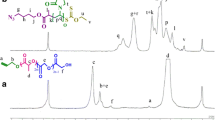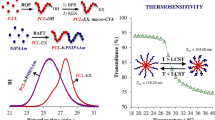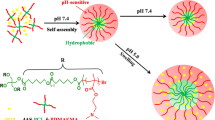Abstract
A novel method has been used to prepare the self-assembled supramolecular micelles which aid in the delivery of anticancer drugs. α-Cyclodextrin (α-CD) induces a micellization process of poly(ε-caprolactone-block-4-vinylpyridine) (PCL-b-P4VP) copolymers through selective inclusion of PCL segments into the cavity of α-CD, resulting in the formation of pseudopolyrotaxane-b-P4VP. Compound pseudopolyrotaxane-b-P4VP forms supramolecular micelles in aqueous medium through self-assembly, which has been characterized using various analytical techniques. The resultant complex micelles consist of pseudopolyrotaxane as the core and P4VP chains in the outer shell, and the micelles possess a well-defined spherical morphology. The self-assembly process can easily be tailor-made by varying the number of PCL and P4VP segments in the PCL x -b-P4VP y copolymer. The arrangement of pseudopolyrotaxane-b-P4VP in the form of “channel-type” crystallites (derived from the supramolecular columns) is confirmed from the wide-angle X-ray diffraction (WAXD) patterns as well as by the composition of the inclusion complexes (ICs) calculated via proton nuclear magnetic resonance (1H NMR) spectral data. The biocompatibility of the micelles was evaluated by a cell viability test and the results revealed excellent cytocompatibility. The prepared micelles were used as carriers for the model anticancer drug doxorubicin (DOX) and successful drug release was observed with a loading content of 14.4 % (w/w) and a loading efficiency of 28.9 %. In vitro drug delivery was evaluated in phosphate-buffered saline (PBS) solution. DOX release from the micelles was considerably faster at pH 5.0 in comparison to a physiological pH of 7.4. The development of supramolecular self-assembled micelles based on partial IC formation between α-CD and compatible block copolymers opens a new, facile and attractive approach for designing novel drug carriers for future pharmaceutical applications.











Similar content being viewed by others
References
Boris R (2011) Adaptive supramolecular nanomaterials based on strong noncovalent interactions. ACS Nano 5:6791–6818
Appel EA, Barrio JB, Loh XJ, Scherman OA (2011) Supramolecular polymeric hydrogels. Chem Soc Rev 41:6195–6214
D’Souza VT, Lipkowitz KB (1998) Cyclodextrins: introduction. Chem Rev 98:1741
Rekharsky MV, Inoue Y (1998) Complexation thermodynamics of cyclodextrins. Chem Rev 98:18754
Crini G (2014) Review: a history of cyclodextrins. Chem Rev 114:10940–10975
Chen G, Jiang M (2011) Cyclodextrin-based inclusion complexation bridging supramolecular chemistry and macromolecular self-assembly. Chem Soc Rev 40:2254–2266
Harada A, Takashima Y, Yamaguchi H (2009) Cyclodextrin-based supramolecular polymers chem. Sociol Rev 38:875–882
Leggio C, Anselmi M, Di Nola A, Galantini L, Jover A, Meijide F, Pavel NV, Soto Tellini VH, Tato JV (2007) Study on the structure of host-guest supramolecular polymers. Macromolecules 40:5899–5906
Zhanga J, Ma PX (2010) Host–guest interactions mediated nano-assemblies using cyclodextrin-containing hydrophilic polymers and their biomedical applications. Nano Today 5:337–350
Alexandridis P, Lindman B (2000) Amphiphilic block copolymers: self-assembly and applications. Elsevier, Amsterdam
Robinson JR, Lee VH (1987) Controlled drug delivery: fundamentals and applications, 2nd edn. Marcel Dekker, New York
Miller AC, Bershteyn A, Tan W, Hammond PT, Cohen RE, Irvine DJ (2009) Block copolymer micelles as nanocontainers for controlled release of proteins from biocompatible oil phases. Biomacromolecules 10:732–741
Tu CW, Kuo SW, Chang FC (2009) Supramolecular self-assembly through inclusion complex formation between poly (ethylene oxide-b-N-isopropylacrylamide) block copolymer and α-cyclodextrin. Polymer 50:2958–2966
Liu Y, Zhao D, Ma R, Xiong D, An Y, Shi L (2009) Chaperone-like α-cyclodextrins assisted self-assembly of double hydrophilic block copolymers in aqueous medium. Polymer 50:855–859
Lu CH, Huang CF, Kuo SW, Chang FC (2009) Synthesis and characterization of poly (ε-caprolactone-b-4-vinylpyridine): initiation, polymerization, solution morphology, and gold metalation. Macromolecules 42:1067–1078
Li J, Chen B, Wang X, Goh SH (2004) Preparation and characterization of inclusion complexes formed by biodegradable poly(ε-caprolactone)–poly(tetrahydrofuran)–poly(ε-caprolactone) triblock copolymer and cyclodextrins. Polymer 45:1777–1785
Prasannan A, Bich-Tram TL, Hsu DY, Hong PD (2013) Nucleation effects of α-cyclodextrin inclusion complexes on the crystallization behavior of biodegradable poly (1, 4-butylene adipate). CrystEngComm 15:5119–5126
Zhao SP, Xu WL (2010) Thermo-sensitive hydrogels formed from the photocrosslinkable polypseudorotaxanes consisting of β-cyclodextrin and Pluronic F68/PCL macromer. J Polym Res 17:503–510
Hong JY, Hong JL (2004) Supramolecular assembly between polystyrene-block-Poly(4-vinylpyridine) and 4-dodecylbenzenesulfonic acid. J Polym Res 11:89–97
Zhang Z, Ding J, Chen X, Xiao C, He C, Zhuang X, Chen L, Chen X (2013) Intracellular pH-sensitive supramolecular amphiphiles based on host–guest recognition between benzimidazole and β-cyclodextrin as potential drug delivery vehicles. Polym Chem 4:3265–3271
Author information
Authors and Affiliations
Corresponding author
Rights and permissions
About this article
Cite this article
Chuang, CC., Li, CH., Prasannan, A. et al. Preparation of a drug carrier through α-cyclodextrin-induced micellization of poly(ε-caprolactone-block-4-vinylpyridine) for controlled delivery of doxorubicin. J Polym Res 22, 206 (2015). https://doi.org/10.1007/s10965-015-0842-z
Received:
Accepted:
Published:
DOI: https://doi.org/10.1007/s10965-015-0842-z




